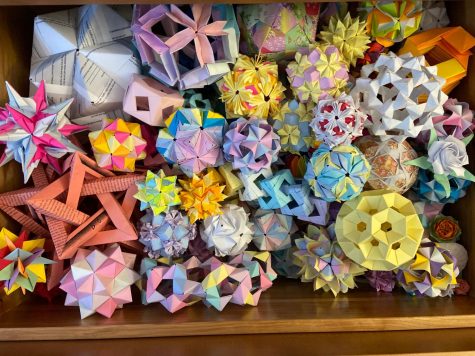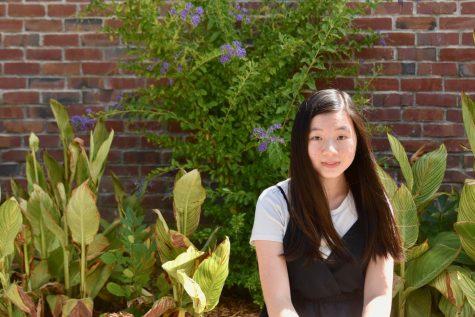Crafting origami creations
Three MVHS students share the process behind the art of paper folding
April 9, 2020
Senior Alicia Chen got her start in origami early on. When Chen was in second grade, her family had an art encyclopedia at home that covered art forms ranging from paper mache to sculpting, but Chen found herself particularly drawn to the origami section. This, coupled with help from her grandpa, sparked her interest in origami.

Senior Alicia Chen stores her collection of origami creations.
“Once, he made me a box, and I was just mind blown, like, ‘Whoa, you can turn a piece of paper into a box,’” Chen said. “Then, he taught me how to do it. My first attempts — they were absolutely terrible. It would be a compliment to call them boxes. If you crumpled a piece of paper up, it was more like that.”
Despite Chen’s rough start, she has fine-tuned her folding skills over the years, gradually learning to make more advanced creations. Sophomore Kyle Zhao and senior Patricia Saito had similar experiences, as both of them started origami in elementary school, then worked their way up in complexity using YouTube videos. Saito believes that regardless of what method or tutorials used, gaining experience is the most important part, especially for beginners.
“Be stubborn because sometimes, origami isn’t the most clear thing out there,” Saito said. “You can try online lessons or stuff like that, but in the end, how you learn is basically just [folding] a lot of things and [seeing] how different things come together. It’s a matter of [making] sure you are willing to work to gain that experience.”
Zhao’s first experience with origami echoes Saito’s philosophy. In third grade, when Zhao’s friends gave him a braided wreath but refused to teach him how to make it, he unfolded the pieces and learned to recreate it himself.
“You just have a piece of paper and you can bring it around with you anywhere,” Zhao said. “You can just put it in your pocket. I think that’s how I got interested in it because you can do it anywhere.”
Chen also enjoys its convenience and folds while at school, often repurposing her schoolwork into origami.
“I just get my old homework, construction paper, lined paper, usually anything I have on hand — I don’t usually carry actual origami paper with me all the time,” Chen said. “I don’t like to throw stuff away, so I usually have a bunch of paper that I don’t use anymore, so you know what, APUSH students, if you’re listening to this, please get into origami. It’s a nice way to use all the papers that [APUSH teachers Bonnie] Belshe and [David] Hartford give you.”
Unlike Chen, Saito usually carries a pack of origami paper in her backpack, which is either purchased from Daiso (a Japanese dollar store franchise) or gifted to her by friends.
“If there’s a lecture going on and we’re taking notes, I’ll just keep folding stuff as long as I’m not writing,” Saito said. “If it’s a lecture where we don’t have to write anything, I will be folding the entire time — not because I hate a class, but it’s because I have a hard time focusing unless I’m doing something with my hands and origami counteracts that.”
Though Zhao, Saito and Chen fold at school, they typically make more complex items at home — including an eagle that took Chen one hour or a dragonfly that took Zhao eight hours. As Chen worked her way up to these creations, she has encountered some challenges. Once, three layers and several hours into trying to make a hexagon tessellation, Chen eventually had to give up, which she deems “not [her] proudest moment.”
Saito agrees, noting that “there’s a million different ways to fail” with origami, whether it’s an issue with the quality of the paper or a confusing step in a tutorial. Either way, Saito says the only option is to let it go and find something else to fold or improvise and live with it.
“Especially for me, I am extremely picky about details and geometric perfection, as much as possible,” Saito said. “Sometimes the model gets too complicated, and you go from being really precise to practically sculpting clay because there’s so many layers, and perfection is not possible, so you just squish it and hope for the best.”
With simpler creations, Saito typically folds several versions, using her later attempts to perfect the model and make it more precise.
“I have a lot of repeats, so I usually give them to people if they want it,” Saito said. “Especially [because] a lot of my folding happens at school, I give it to teachers. I assume they have mixed feelings about me giving them origami I made during their class, but my teachers are pretty used to it.”
Chen has also given her origami to friends and a handful of teachers at MVHS. She says she’s given the most to AP Computer Science teacher Scott DeRuiter, who now keeps a collection of about 10 or 12 from Chen displayed above the cabinets in his classroom. They range from modular origami balls to a three dimensional ring to a set of three roses.
“They’re amazing; they’re spectacular,” DeRuiter said. “Even the simplest ones are not that simple, are kind of dodecahedrons and icosahedrons. They look mostly like balls, but there’s uniformity to it. In addition to having technical skills, she also has some excellent artistic skills. She’s obviously an artist, and so she does a great job of color matching patterns, pastels that go together or browns and blues and greens that go together nicely, so they’re very pretty.”
One of Chen’s proudest creations is a modular origami ball that she designed and later gave to DeRuiter. Zhao has done something similar, using the mathematical aspects of origami to calculate angles and ensure each unit folds flat in the geometric model. In Chen’s case, she decided to name the units she designed after DeRuiter.
“[I] usually [give origami to] people I like and appreciate in my life,” Chen said. “It’s something you’ve put your heart and soul into and you give it to someone — I feel like it’s a rewarding feeling if they end up liking it.”
Though DeRuiter hasn’t tried origami himself, claiming that he doesn’t have the patience to do it, he admires Chen’s skills and the time she puts into it. He had seen her creations earlier in the year but says he couldn’t believe it when she started giving them to him towards the end of the second semester.
“All these hours of work [and] she’s willing to share them with me,” DeRuiter said. “I’m honored to receive them and be able to display them in my classroom. Alicia is one of my favorite students. She’s not a student of mine anymore this year, but I’m very happy to talk about her and hope she keeps doing it.”
Chen, Saito and Zhao all have plans for their next origami creations — a modular origami ball, a horse and tessellations respectively. For aspiring origamists who want to dive into the art of paper folding, Chen offers some advice.

















